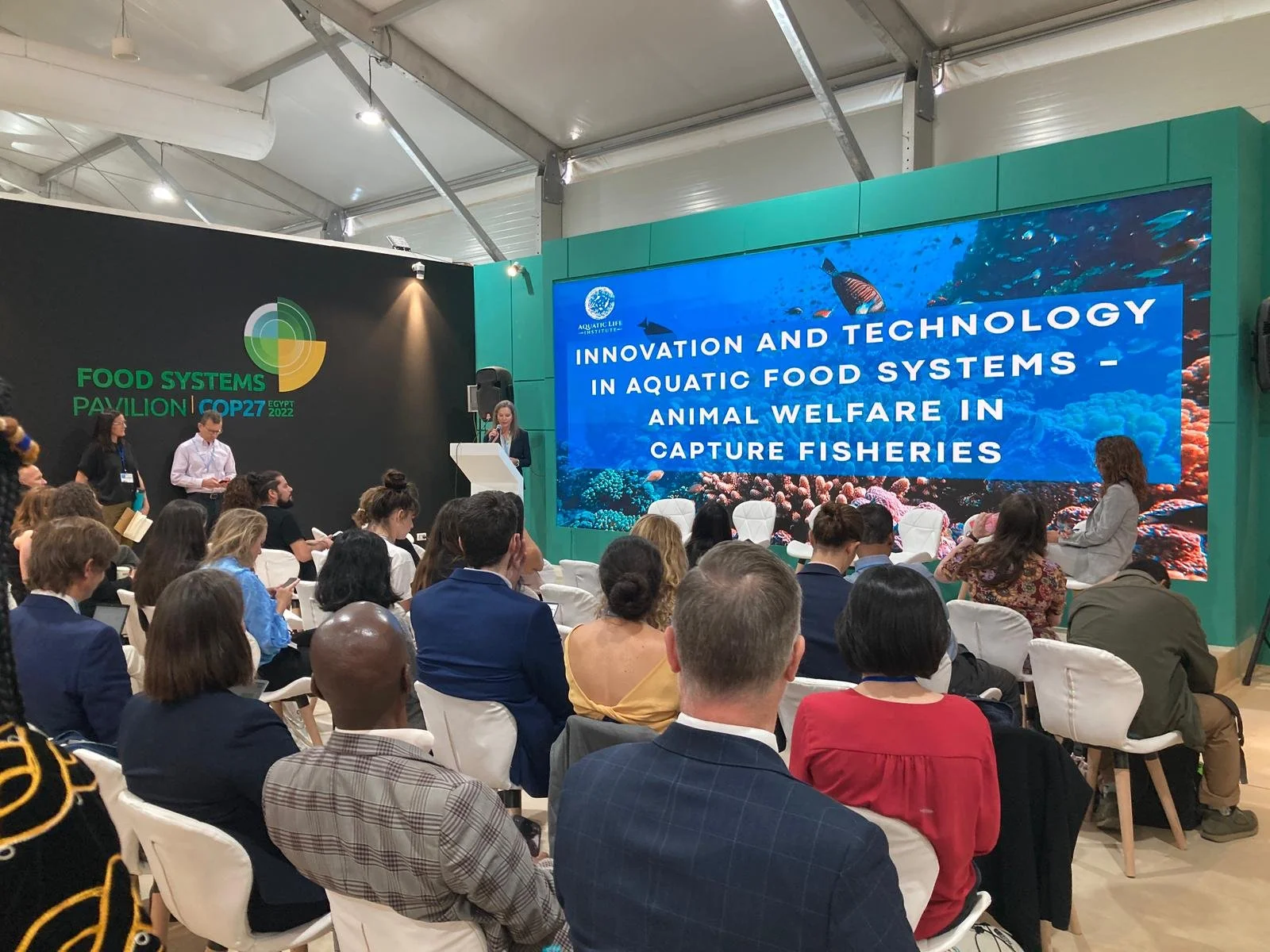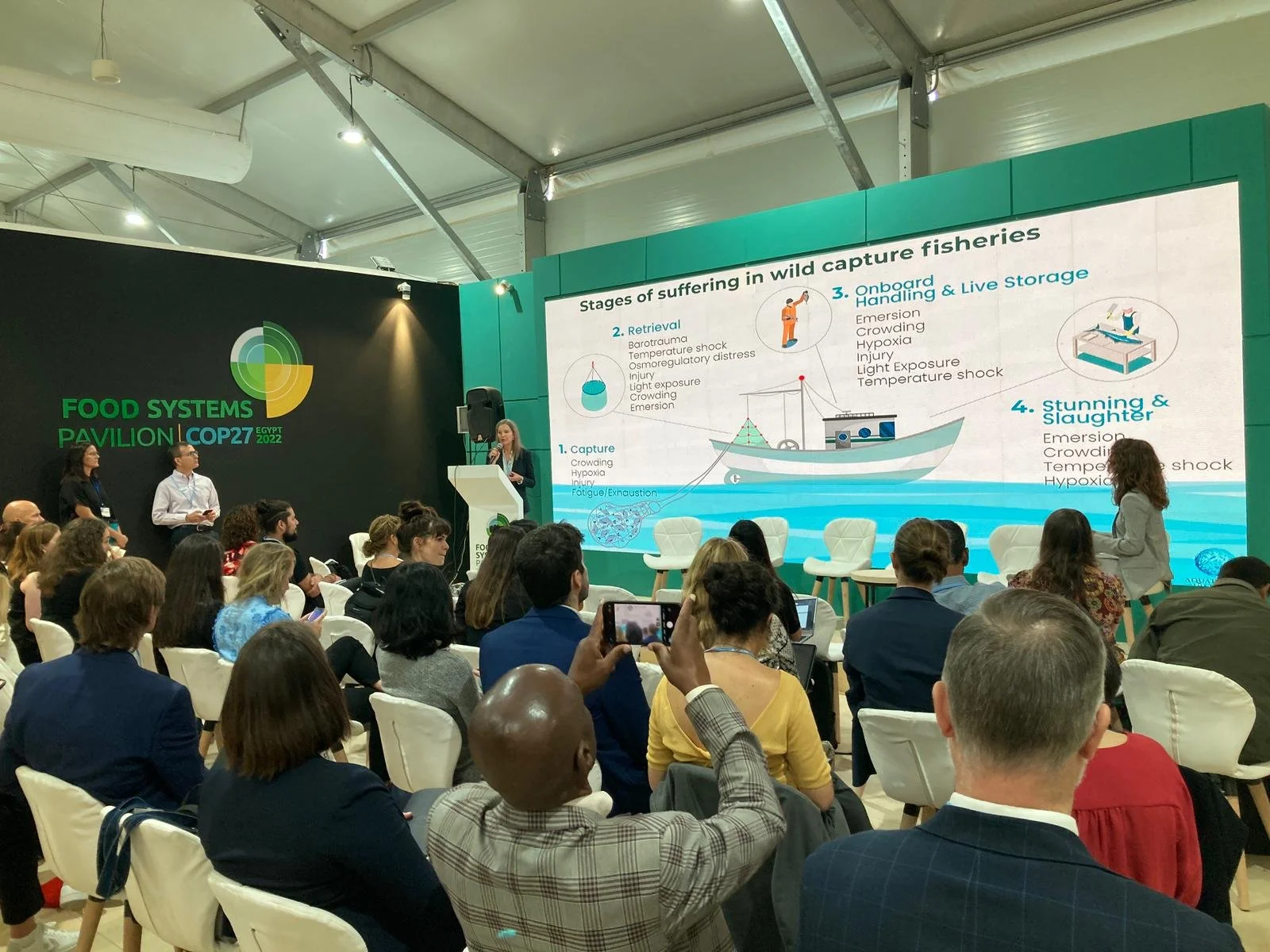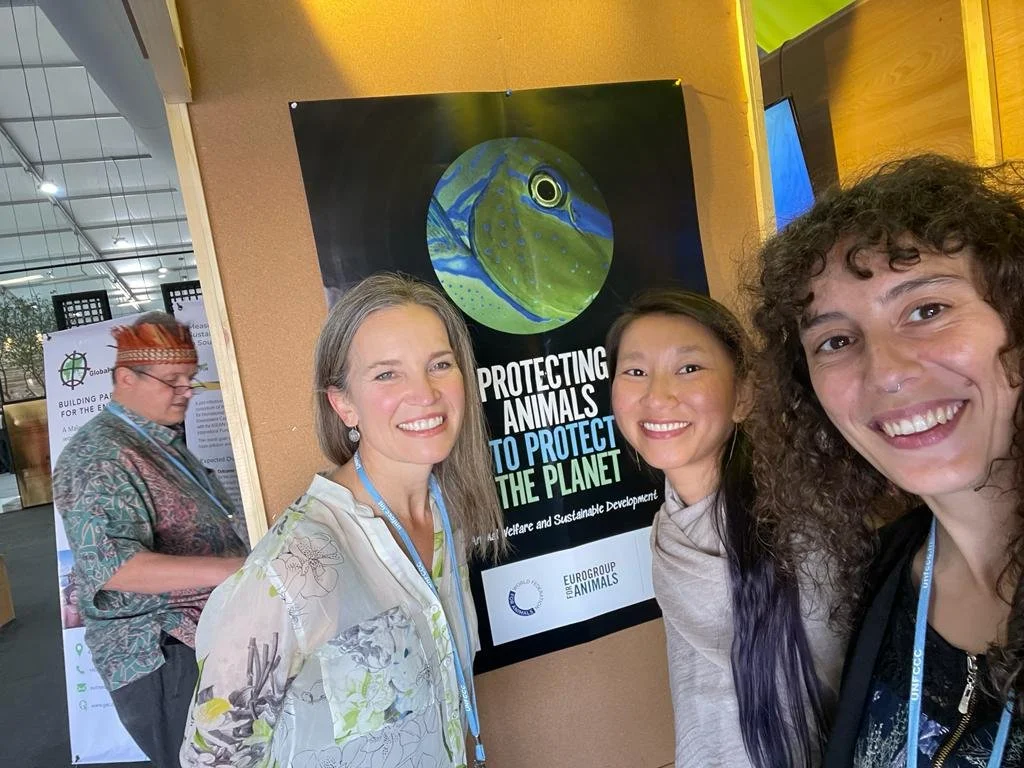What Happened at COP27 for Aquatic Animals?
What does the first “food” COP mean for aquatic animals?
ALI Director, Sophika Kostyniuk, speaks at COP27 on Nov. 14 in the Food Systems Pavilion on Innovation and Technology for Humane Capture Fisheries
Between November 9 and 15th, three team members from the Aquatic Life Institute attended COP27 in Egypt. This was dubbed as the first ‘food’ COP - the first time to have pavilions specifically dedicated to food systems. This was also our team’s first time attending COP27.
Why a ‘Food” COP?
In recent years, increasing focus has been placed on the impacts of agriculture, from deforestation to intensive animal agriculture, on climate change. And only a couple of years ago did “sustainable food systems,” “a just food systems transition” and “eating within planetary boundaries” emerge as buzz words in the public/policy domain. Last year, the UN held the first Food Systems Summit, and this year, food systems discussions and negotiations were centerpieces to COP27 activities.
We were pleased to see several pavilions (or ‘booths’ within COP’s meeting grounds) in the Blue Zone (accreditation only) focused entirely on food and agriculture, and an ocean pavilion in the Blue Zone for the first time, while many more held sessions related to agriculture, smallholder farmers, food security, and food innovations. The acknowledgement of food and agriculture in climate change discussions is a huge step in the right direction towards achieving a stable climate, food security and biodiversity.
Food4Climate Pavilion
Food Systems Pavilion
Ocean Pavilion
Where Do Aquatic Animals Fit?
We were excited to attend the myriad of food systems-related side events, but were also very disappointed to see the UN itself promote increasing consumption of seafood as a “sustainable protein” to farmed land animals. It was our goal this year (and going forward) to get this message across: “blue foods” (aka aquatic animals) is not the solution to our problems related to intensive animal agriculture, food security and agricultural emissions.
Fish Feed Inefficiencies
Already, nearly 90% of the world’s fish populations are now fully exploited, overexploited or depleted. Further, around 20% of the world’s commercially-caught fish, in terms of tonnage, are turned into feed for farmed animals, mostly for farmed fish. This translates to around 1.2 trillion individual animals. For instance, 120 anchovies are needed from the wild to bring one farmed salmon to harvest weight. The inefficiencies of feed ratio and unsustainable farming of carnivorous species like salmon are just two reasons why we should actually reduce fishing and our consumption of fish.
Climate Change from Fishing and Aquaculture
Another reason is directly related to climate change. Producing aquatic animal foods through fishing or aquaculture can result in high GHG emissions, in some cases with CO2 emissions per unit of protein comparable to or exceeding those of beef. Capture fisheries contribute to climate change through emissions from fishing vessels and direct disturbance to ocean sediments, as well as loss of carbon sequestration capacity due to the removal of aquatic animals (both fish and marine mammals). In fact, the concept of “fish carbon” is increasingly gaining traction. A particularly harmful method is ‘bottom trawling’, a significant contributor to overfishing that releases massive amounts of carbon which would otherwise be stored in the seabed. At the ecosystem level, it can displace entire benthic communities through habitat destruction and disrupt the marine food chain.
Aquatic Animal Welfare Concerns
Finally, aquaculture and capture fisheries inflict major animal welfare concerns to aquatic animals. Currently, 100 billion fish and 400 billion shrimp are farmed, while 2-3 trillion fishes are caught in the wild. Compared to the 70 billion farmed land animals, this is 35x more, and equates to 6 million aquatic animals killed every minute. The majority of these animals are not reared nor caught with their welfare in mind. Currently, national and international regulations largely fail to protect aquatic animals nor recognize their sentience.
At this year’s COP27, aquatic animals were in general nonexistent on the agenda. However, we were pleased to have been invited by the Environmental Defense Fund to present on their panel titled Innovation and Technology in Water and Blue Food Systems. Our Managing Director presented to a packed room on innovative technology for humane capture fisheries. Other panelists include Bruce Friedrich from GFI, Shannon Cosentino-Roush from Finless Foods, Livia Peiser from FAO, and more.
Photos from our panel presentation
In our opinion, positive progress always starts with dialogue, which in time will translate to action. So the fact that this was our first time attending COP and that we had the opportunity to speak about this issue, both of global importance and dear to our hearts, was a great first COP. Further, we were also extremely heartened to see the Co-founder of alternative meat company, Heura, speak passionately about aquatic animal welfare and the need to invest in alternative seafood.
Photos from Heura’s presentations
If you would like to read more, we published a position paper on Animal Welfare: A Must in the Climate Change Negotiations with our partners and hosted a booth at COP27 to discuss this very topic. Going forward, we will continue to spread awareness and conduct policy campaigns to bring legal protections to aquatic animals.
You can make a positive difference for aquatic animals by supporting our work.
Team at COP27 - thank you for supporting our work!














